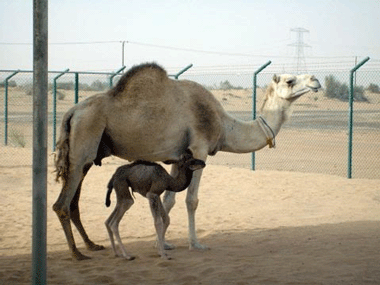
Dubai scientists create first cloned camel
Injaz was born on April 8. Courtesy The Central Veterinary Research LaboratorScientists in Dubai have created the world’s first cloned camel, offering a way to preserve special strains for racing and milk production.
The female calf, named Injaz, was born at 4.30pm on April 8 and is healthy so far.
Injaz is the result of five years of work by scientists at the Camel Reproduction Centre and the Central Veterinary Research Laboratory (CVRL) in a project initiated by Sheikh Mohammed bin Rashid, Vice President of the UAE and Ruler of Dubai.
“This is the first time scientists have cloned a camel calf,” said Dr Ulrich Wernery, the scientific director at CVRL.
“She is a healthy female.”
The surrogate mother, which carried the embryo for a gestation period of 378 days, was also in good shape, he said.
Dr Lulu Skidmore, the scientific director at the Camel Reproduction Centre, said: “We are all very excited at the birth of Injaz as she is the result of great skill and teamwork of everyone at the Camel Reproduction Centre.
“This significant breakthrough in our research programme gives a means of preserving the valuable genetics of our elite racing and milk-producing camels in the future.”
The project began in 2003 at CVRL, where an Indian scientist, Dr Nisar Wani, under the supervision of Dr Ali Ridha, developed the techniques to produce a “reconstructed embryo” – an embryo carrying the DNA of a single donor animal. The embryo is created in the laboratory using eggs harvested from a female.
Scientists extract the DNA from the egg, replace it with the DNA of an adult animal, and then encourage the egg to develop into an embryo.
The embryo is then inserted into the uterus of a surrogate mother, which, if the procedure is successful, will carry the embryo to full term.
In 2007 Dr Wani moved to the Camel Reproduction Centre, where he worked with Dr Skidmore, an expert in embryo transfer, on implanting reconstructed embryos in surrogate mothers.
Injaz is the clone of a camel that was slaughtered for its meat in 2005, using DNA extracted from cells in the ovaries of that animal.
The DNA was placed in an egg taken from the surrogate mother to create a reconstructed embryo, and the embryo was then implanted in the surrogate mother’s uterus.
Injaz was the only live calf from seven induced pregnancies.
Dr Wernery said the low success rate was typical of cloning, since many of the impregnated animals miscarry.
“This is very typical for cloning, there are many attempts but only one will survive,” he said.
While Injaz was replicated from a camel chosen at random, in future scientists will look into cloning elite racing and milk camels – an idea supported by Sheikh Mohammed.
“We just wanted to establish the method,” Dr Wernery said. “In future we can most probably clone some special animals.”
Although proponents say cloning animals can help science create new, more effective drugs for humans, the practice has been opposed on ethical grounds.
Critics say the production of a clone involves subjecting animals to painful or risky procedures.
Mothers impregnated with reconstructed embryos often miscarry or give birth to abnormally large young.
Dolly the sheep, the first mammal to be cloned, was diagnosed with arthritis only five and a half years after her birth and died of a lung disease common to older animals a year later. Scientists are now trying to find out whether using the DNA of an older animal to create an embryo puts clones at risk of premature ageing.
Despite advances in the technique that now allow scientists to clone horses, cats and other animals, Dr Wernery believes cloning will remain in the domain of scientific research for a long time to come. “It has more to do with scientific curiosity,” he said. “It is not something for mass production.”
